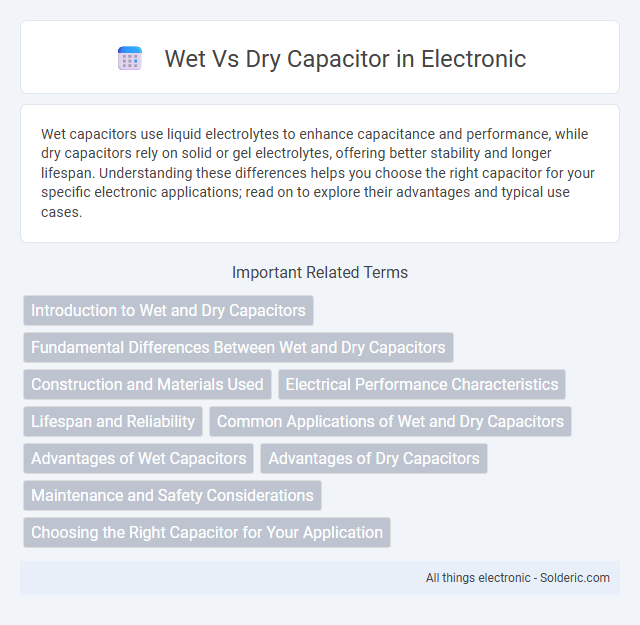Wet capacitors use liquid electrolytes to enhance capacitance and performance, while dry capacitors rely on solid or gel electrolytes, offering better stability and longer lifespan. Understanding these differences helps you choose the right capacitor for your specific electronic applications; read on to explore their advantages and typical use cases.
Comparison Table
| Feature | Wet Capacitor | Dry Capacitor |
|---|---|---|
| Dielectric Medium | Liquid electrolyte | Solid dielectric |
| Construction | Metal case sealed with liquid electrolyte inside | Solid layers without liquid, often ceramic or plastic |
| Voltage Rating | Typically lower voltage, suitable for AC motors | Higher voltage tolerance for precise electronic circuits |
| Temperature Range | Limited by electrolyte evaporation, moderate range | Wide temperature range, stable under harsh conditions |
| Lifespan | Shorter due to electrolyte degradation | Longer, more durable and maintenance-free |
| Applications | AC motor start/run, HVAC systems | Electronics, power supplies, signal processing |
| Cost | Generally less expensive | Higher cost but better performance |
Introduction to Wet and Dry Capacitors
Wet capacitors use a liquid electrolyte to achieve higher capacitance and better cooling performance, making them ideal for high-current applications. Dry capacitors rely on a solid dielectric material, ensuring greater reliability, longer lifespan, and reduced risk of leaks or maintenance issues. Choosing the right capacitor type affects your device's efficiency and durability based on the operational requirements.
Fundamental Differences Between Wet and Dry Capacitors
Wet capacitors use a liquid electrolyte, providing higher capacitance and better cooling but posing risks of leakage and corrosion, while dry capacitors contain a solid or gel electrolyte that offers enhanced reliability, longer lifespan, and greater stability under varying temperatures. Wet capacitors are typically suited for high-power applications like motor start and power factor correction due to their robust energy storage capabilities. Dry capacitors are preferred in electronics and precision circuits where safety, durability, and minimal maintenance are critical factors.
Construction and Materials Used
Wet capacitors use a liquid electrolyte, often a conductive fluid like electrolyte gel or boric acid solution, contained within a sealed metal casing that provides excellent heat dissipation and prevents leakage. In contrast, dry capacitors utilize solid dielectrics such as ceramic, mica, plastic films, or paper impregnated with resin, housed in non-metallic or metal enclosures designed to withstand high temperatures without fluid exposure. The construction differences influence their electrical performance, with wet capacitors offering higher capacitance values and better stability under load, while dry capacitors provide enhanced reliability and safety in varied environmental conditions.
Electrical Performance Characteristics
Wet capacitors typically offer higher capacitance stability and longer service life under varying temperature and voltage conditions due to their liquid dielectric, which ensures better heat dissipation and self-healing properties. Dry capacitors, using solid or paper dielectric, exhibit lower leakage currents and faster response times, making them suitable for high-frequency applications and circuits requiring precise performance. The choice between wet and dry capacitors depends on electrical parameters such as voltage rating, equivalent series resistance (ESR), and operating frequency, with wet capacitors excelling in high voltage and ripple current scenarios, while dry capacitors dominate in compact, high-speed electronics.
Lifespan and Reliability
Wet capacitors generally exhibit a longer lifespan and higher reliability due to their liquid electrolyte, which provides better cooling and reduces the risk of internal drying or cracking. Dry capacitors, while less prone to leakage, tend to have a shorter operational life as their solid dielectric material can degrade faster under thermal and electrical stress. Choosing between wet and dry capacitors depends on application-specific requirements for durability and consistent performance under varying environmental conditions.
Common Applications of Wet and Dry Capacitors
Wet capacitors are predominantly used in high-voltage applications such as power factor correction in industrial plants and electrical substations due to their superior tolerance for high temperature and ripple currents. Dry capacitors find common applications in low-voltage electronic circuits, including signal processing, audio equipment, and precision timing devices, where stability and low loss are critical. Both types are essential in specialized fields like renewable energy systems, with wet capacitors handling grid-scale power management and dry capacitors used in control and monitoring electronics.
Advantages of Wet Capacitors
Wet capacitors offer superior heat dissipation and longer lifespan compared to dry capacitors, making them ideal for industrial and high-power applications. Their liquid electrolyte provides better self-healing properties, reducing the risk of failure and enhancing reliability. You benefit from improved performance in demanding environments where stability and durability are critical.
Advantages of Dry Capacitors
Dry capacitors offer superior safety due to their non-liquid dielectric material, reducing risks of leaks and corrosion. They provide enhanced reliability and longer lifespan in high-temperature and harsh environmental conditions. Maintenance costs decrease significantly with dry capacitors, making them ideal for industrial and power electronic applications.
Maintenance and Safety Considerations
Wet capacitors require regular maintenance due to the potential for electrolyte leakage, which can cause corrosion and pose safety hazards. Dry capacitors are low-maintenance and eliminate risks associated with liquid leakage, making them safer for long-term use in sensitive electrical equipment. Proper inspection schedules and safety protocols are essential for wet capacitors to prevent operational failures and ensure reliable performance.
Choosing the Right Capacitor for Your Application
Selecting the right capacitor for your application depends on factors such as voltage rating, temperature tolerance, and longevity. Wet capacitors, filled with electrolyte, typically offer higher capacitance and longer lifespans but may be bulkier and sensitive to temperature variations. Dry capacitors, with solid dielectrics, provide greater stability and lower leakage, making them ideal for precision circuits and environments where durability is crucial.
Wet vs dry capacitor Infographic

 solderic.com
solderic.com